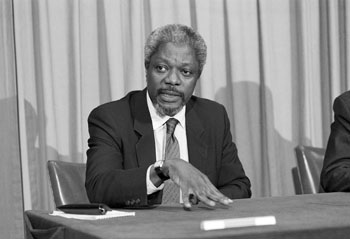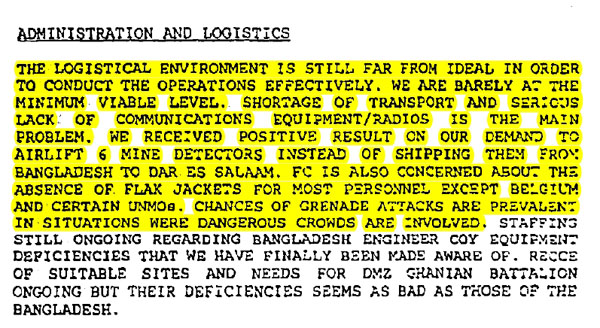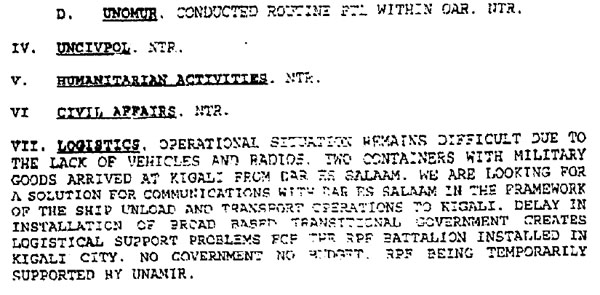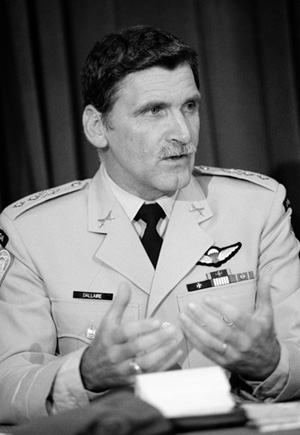IN THE NEWS
The Shroud Over Rwanda's Nightmare
By Michael Dobbs, The New York Times, January 9, 2014
"The Rwandan Genocide," Letter to the Editor, The New York Times
By Rafael Medoff
January 10, 2014
"The Rwandan Genocide," Letter to the Editor, The New York Times
By Linda Melvern, Gregory Stanton, et al.
January 15, 2014
RELATED POSTS
The Rwanda "Genocide Fax": What We Know Now
New Documentation Paints Complex Picture of Informant and his Warnings
January 9, 2014
The U.S. and the Genocide in Rwanda 1994: The Assassination of the Presidents and the Beginning of the "Apocalypse"
April 7, 2004
The U.S. and the Genocide in Rwanda 1994: Information, Intelligence and the U.S. Response
March 24, 2004
The U.S. and the Genocide in Rwanda 1994: Evidence of Inaction
August 20, 2001
Lessons Learned from U.S. Humanitarian Interventions Abroad
May 9, 2000


|
Washington, DC, February 3, 2014 – Three months after its arrival, the United Nations Assistance Mission for Rwanda (UNAMIR) remained ill-equipped and unprepared to respond to the rising threat of violence and political instability, according to the first of dozens of UNAMIR situation reports (sitreps) being posted by the National Security Archive as part of the “#Rwanda20yrs” Project. These daily messages to UN headquarters in New York detail how the lack of equipment and support from the international community left UNAMIR without the capacity for rapid reaction to violence and opened the door for the genocide that killed between 500,000 and a million Rwandans, predominately Tutsi, between April and July 1994.
This is the second in a series of postings from the joint "#Rwanda20yrs" project co-sponsored by the National Security Archive at George Washington University and the Simon-Skjodt Center for the Prevention of Genocide at the United States Holocaust Memorial Museum. Forthcoming postings will explore the French and Belgian perspectives, a broader look at the UNAMIR sitreps, the refugee crisis, the UNAMIR withdraw, and intelligence, among others issues.
 |
Under-Secretary-General for Peacekeeping Operations in 1994, Kofi Annan, who received the daily and weekly Sitreps - photo courtesy of the United Nations |
The UNAMIR sitreps — a rich resource providing an on-the-ground perspective of the complicated situation facing the U.N. peacekeepers and the larger situation of political instability in Rwanda at the time — are available on the International Criminal Tribunal for Rwanda’s (ICTR) cumbersome website database among thousands of other pieces of evidence submitted to the ICTR trials. Today’s posting includes 17 sitreps from the beginning of the peacekeepers’ deployment in October 1993 through the end of January 1994, when the warnings of imminent violence reached a crescendo. Rich accounts in existing literature detail the international community’s failure to provide basic supplies, leaving UNAMIR “desperately understaffed and ill-equipped.” [1] Sitreps become extraordinarily valuable for reconstructing the day-by-day lead-up to the genocide, perhaps most of all during the events of April 1994. Here we are posting a selection of the January 1994 sitreps in order to illuminate one of the core problems with the international response (and lack thereof) to the imminent genocide in Rwanda.
The UN peacekeepers in Rwanda were mandated to monitor the cease-fire, and to help implement the Arusha Accords, a peace agreement between the Rwandan government and the predominately Tutsi rebel group, the Rwandan Patriotic Front (RPF). The main objectives of the Arusha Accords were to end the war between the RPF and Rwandan military, install a new “transitional” government, demobilize and integrate the two parties’ military forces, and pave the way for democratic elections. However, from the beginning of its mandate in the fall of 1993, UNAMIR lacked logistical and financial support, making an already complex mission all the more challenging to accomplish.
Starting in October 1993, UNAMIR Force Commander General Roméo Dallaire and his civilian superior, Special Representative to the Secretary General (SRSG) Jacques-Roger Booh-Booh, continuously petitioned the UN headquarters in New York for supplies in the daily and weekly “situation reports” (sitreps), requesting communication equipment, vehicles, and medical supplies.
By January 1994, three months after the official start of UNAMIR, the situation was still dire. A weekly sitrep from January 11th reports that "The logistical environment is still far from ideal in order to conduct the operations effectively. We are barely at the minimum viable level. Shortage of transport and serious lack of communications equipment/radios is the main problem."
 |
Excerpt from January 11, 1994 weekly SITREP – “Logistical environment is still far from ideal in order to conduct the operations effectively.” |
The January 15, 1994, daily sitrep is just one of many in which Booh-Booh reported that the "operational situation remains difficult due to the lack of vehicles and radios"-- a daily refrain Dallaire and Booh-Booh repeat in the following weeks.
 |
Excerpt from January 15, 1994 daily SITREP – “Operational situation remains difficult due to the lack of vehicles and radios” |
While the lack of supplies and equipment produced difficulties for everyday operations of the mission, basic logistical planning was also a major problem. A daily sitrep on January 11th explains that a group of UNAMIR drivers were ordered to go to Dar es Salaam, Tanzania, to retrieve a convoy of eight APCs (armored personnel carriers), but were unable to complete the mission because "no drivers with appropriate driver license [were] available in the UNAMIR Bangladesh contingent." Even when there was equipment available, UNAMIR had a hard time actually getting hold of it.
 |
Excerpt from January 11, 1994 weekly SITREP – “No drivers with appropriate driver license available to bring APCs from Dar es Salaam” |
Major Brent Beardsley, the military assistant to UNAMIR commander General Dallaire, explained in an interview in 2013 how the peacekeepers tried to make do with a small force, limited equipment, and limited logistical support from the UN in New York, but in the end there was little they could do:
So our point was, if you’re going to be a small force, then you must be a good force, and you must have a lot of mobility. So the key things to us were a rapid reaction company that could be lifted in one lift by helicopter, so we needed helicopter mobility, and could respond by road with armored personnel carriers. So about 16 of each, helicopters and armored personnel carriers was the real meat of our force… [The] rapid reaction force never came. We never got our helicopters. This is October, the mission’s approved, the helicopters do not arrive until the first of April; we get two. And they’re civilian contractor helicopters. So on the morning of the seventh [of April 1994], when things blow up in Kigali, the pilots jump on the helicopters, fly away, and they don’t come back, because nobody will insure the helicopters.
Logistical complications continued to plague UNAMIR in the following months, making an already complex and tedious situation all the more frustrating for the UN soldiers.
-
THE DOCUMENTS
DOCUMENT 1
DATE: October 25, 1993
TO: Barril for Annan, UNations New York
FROM: Dallaire, Force Commander, UNAMIR, Kigali, Rwanda
SUBJ: UNAMIR Situation Report 1
The first UNAMIR sitrep sent in late October 1993 sets the stage for months of logistical failures, reporting that the peacekeepers are “locally renting vehicles but the situation is most difficult as costs and availability [are] causing serious difficulties.” It also reports that a “secure fax line is available, but no qualified personnel to either install it nor any of the other ADP assets now coming in.”
DOCUMENT 2
DATE: January 1, 1994
TO: Annan, UNations
FROM: J.-R. Booh-Booh, SRSG, UNAMIR, Kigali, Rwanda
SUBJ: Daily Sitrep 310600B Dec 93 to 010600B Jan 94
No. MIR 001
The first sitrep of 1994 details of increasing tensions and violence during which “two UNMOs from Senegal, Capt. Fallou and Capt. Dia were attacked by a group of unidentified individuals…armed with knives, batons, and grenades.”
DOCUMENT 3
DATE: January 5, 1994
TO: Annan, UNations, New York
FROM: J.-R. Booh-Booh, SRSG, UNAMIR, Kigali, Rwanda
SUBJ: Daily Sitrep 040600B Jan to 050600B Jan 94
No: MIR 026
As a part of the daily pleas for basic equipment from Booh-Booh and Dallaire in the “Logistics” section, UNAMIR also urgently requests mine detectors: “Request repeat request for your intervention on the following issue. 6 mine detectors are planned to be shipped from Bangladesh to Dar es Salaam. We need these equipments urgently and ask for immediate airlift.”
DOCUMENT 4
DATE: January 7, 1994
TO: Annan, UNations, New York
FROM: J.-R. Booh-Booh, SRSG, UNAMIR, Kigali, Rwanda
SUBJ: Daily Sitrep 060600B Jan to 070600B Jan 94
No: MIR 041
Booh-Booh repeats UNAMIR’s urgent “request for intervention on the issue of 6 mine detectors to be airlifted from Bangladesh. Do not ship them from Bangladesh to Dar es Salaam. These equipments are needed urgently.” Clearing land mines--remnants of the civil war--was a key part of UNAMIR's mandate, however they lacked the basic equipment to clear the mines.
DOCUMENT 5
DATE: January 9, 1994
TO: Annan, UNations, New York
FROM: J.-R. Booh-Booh, SRSG, UNAMIR, Kigali, Rwanda
SUBJ: Daily Sitrep 080600B Jan to 090600B Jan 94
No: MIR 053
This daily sitrep reports on a political demonstration during which “six civilians were injured” and some of UNAMIR’s “civilian drivers were beaten.” Booh-Booh repeats the refrain from previous reports and complains that “operational situation remains difficult due to the lack of vehicles and radios.” He also particularly notes that “the absence of flak jackets for most personnel except Belgium and certain UNMOs is of great concern particularly under current situation where dangerous crowds are involved; chances of grenade attacks are prevalent.”
DOCUMENT 6
DATE: January 11, 1994
TO: Annan, UNations, New York
FROM: Dallaire, UNAMIR, Kigali, Rwanda
SUBJ: Daily Sitrep - Covering Period 100600 Jan to 110600 Jan 94
No: MIR 070
This daily sitrep repeats the daily refrain that “operational situation remains difficult due to the lack of vehicles and radios.” It also reports: “Instructions received on 09 Jan 94 to send drivers to Dar es Salaam for a convoy of 8 APCs and 6 trucks coming from UNOMOZ cannot be executed. No drivers with appropriate driver license being available in the UNAMIR Bangladesh contingent.”
DOCUMENT 7
DATE: January 11, 1994
TO: Annan, UNations, New York
FROM: J.-R. Booh-Booh, SRSG, UNAMIR, Kigali, Rwanda
SUBJ: Weekly Sitrep No 13, 04 Jan 94 – 10 Jan 94
No: MIR 74
In this weekly sitrep, Booh-Booh reports that “the logistical environment is still far from ideal in order to conduct the operations effectively. We are barely at the minimum viable level.” While UNAMIR was pleased to receive a “positive result” on the “demand to airlift 6 mine detectors instead of shipping them from Bangladesh to Dar es Salaam” the force commander “is also concerned about the absence of flak jackets for most personnel except Belgium and certain UNMOs.” Booh-Booh also warns that “chances of grenade attacks are prevalent in situations where dangerous crowds are involved.” He reports on the “deficiencies” of the Bangladesh and Ghanaian peacekeeping troops.
DOCUMENT 8
DATE: January 13, 1994
TO: Annan, UNations, New York
FROM: J.-R. Booh-Booh, SRSG, UNAMIR, Kigali, Rwanda
SUBJ: Daily Sitrep 120600B Jan to 130600B Jan 94
No: MIR 088
This sitrep reports an incident where “an object was thrown into a Belgian patrol jeep. The personnel jumped out of the vehicle thinking it was a grenade. Fortunately it was a stone.” This exemplifies the extreme tension around attacks against and harassment of UNAMIR troops mentioned in previous sitreps. This tension is compounded by the lack of basic equipment such as flak jackets and radios.
The last page of this sitrep, which includes the logistics section, is missing.
DOCUMENT 9
DATE: January 14, 1994
TO: Annan, UNations, New York
FROM: J.-R. Booh-Booh, SRSG, UNAMIR, Kigali, Rwanda
SUBJ: Daily Sitrep 130600B Jan to 140600B Jan 94
No: MIR 096
Booh-Booh repeats the refrain that “the operational situation remains difficult due to the lack of vehicles and radios,” and reports that “the shipment of APCs [armored personnel carriers] forseen for 10 Jan 94 has been delayed till 17 Jan 94.” Even when UNAMIR finally gets the attention of UN headquarters and gets promised much needed equipment, it is delayed.
DOCUMENT 10
DATE: January 15, 1994
TO: Annan, UNations, New York
FROM: J.-R. Booh-Booh, SRSG, UNAMIR, Kigali, Rwanda
SUBJ: Daily Sitrep 140600B Jan to 150600B Jan 94
Now a nearly daily occurrence, Booh-Booh repeats that “the operational situation remains difficult due to the lack of vehicles and radios.” He also reports that a shipment of goods finally arrived to Kigali; however the situation remains dire because UNAMIR is temporarily providing the logistics for the RPF (Rwandan Patriotic Front) rebel contingent in Kigali. The Arusha Accords called for the installment of a new government that would then provide support for the disarmament and demobilization of the government and RPF militaries; however the new government was not put into place.
Booh-Booh explains: “Delay in the failure of the installation of Broad Based Transitional Government creates logistical support problems for the RPF battalion installed in Kigali City. No government, no support. RPF temporarily supported by UNAMIR.” UNAMIR is obligated to provide logistical support to the RPF troops while it cannot even support its own peacekeepers. This exemplifies the mounting pressure for UNAMIR to assist in the implementation of the Arusha Accords, but without support from the international community, even in the form of basic equipment.
DOCUMENT 11
DATE: January 22, 1994
TO: Annan, UNations, New York
FROM: J.-R. Booh-Booh, SRSG, UNAMIR, Kigali, Rwanda
SUBJ: Daily Sitrep 210600B Jan to 220600B Jan 94
No: MIR 162
Booh-Booh reports that peacekeepers “are hearing more and more about the displeasure of the population regarding the political impasse and they are starting to point the finger at us, in questioning our assistance in this matter.” Tensions in Rwanda continue to rise, and the population is increasingly frustrated with the failure to install the new government, a key piece of implementing the Arusha Accords (which UNAMIR was mandated to oversee).
This rising tension about the role that UNAMIR has in moving along the peace process is amplified by the continuing concern for the “operational situation which remains difficult due to the lack of vehicles and radios.” Booh-Booh reports that a shipment of equipment arrived in Kigali, but UNAMIR is still awaiting “a batch of 100 UNTAC vehicles.”
DOCUMENT 12
DATE: January 24, 1994
TO: Annan, UNations, New York
FROM: J.-R. Booh-Booh, SRSG, UNAMIR, Kigali, Rwanda
SUBJ: Daily SITREP 230600B Jan to 240600B Jan 94
No: MIR 167
This sitrep reports that “stones were thrown” at a UNAMIR patrol and a UN helicopter during a protest. A shipment of “about 50 vehicles arrived from Dar es Salaam,” and are being checked out, but Booh-Booh repeats that the “operational situation remains difficult.”
DOCUMENT 13
DATE: January 25, 1994
TO: Annan, UNations, New York
FROM: J.-R. Booh-Booh, SRSG, UNAMIR, Kigali, Rwanda
SUBJ: Daily Sitrep 240600B Jan to 250600B Jan 94
No: MIR 185
Booh-Booh explains in this sitrep that “UNAMIR was informed about the contracting problems for the helicopters. We need these helicopters urgently and UNNY starts today a new contracting procedure.” The “operational situation remains difficult.”
DOCUMENT 14
DATE: January 25, 1994
TO: Annan, UNations, New York
FROM: J.-R. Booh-Booh, SRSG, UNAMIR, Kigali, Rwanda
SUBJ: Weekly Sitrep No 15, 18 Jan 94 – 24 Jan 94
This weekly sitrep explains the details of UANMIR’s logistical problems which are improving, but only slightly. While equipment has been shipped, it is defective, and still leaves much of the peacekeeping force ill-equipped and unprepared:
“The logistical environment is still difficult but stocks are now moving from Dar es Salaam into Kigali. A first batch of 50 vehicles arrived in Kigali, but in a very bad state of disrepair and lots of things missing including radios. Shortage of transport and serious lack of communications equipment/radios are the main problems. For the moment, two Belgian helicopters provide support to the mission… We expected UN helicopters to be available at the beginning of Jan 94. There is still no contract and we were told that the contract procedure has to be overdone. Please note that we are missing very much this valuable equipment and UNAMIR operations are seriously hampered.”
DOCUMENT 15
DATE: January 26, 1994
TO: Annan, UNations, New York
FROM: J.-R. Booh-Booh, SRSG, UNAMIR, Kigali, Rwanda
SUBJ: Daily Sitrep 250600B Jan to 260600B Jan 94
No: MIR 195
Booh-Booh reports that “a second batch of vehicles arrived from Dar es Salaam. They are in very bad state and lots of things are missing. APC/truck convoy crossed Tanzanian/Rwandan border and is expected today at Kigali.”
DOCUMENT 16
DATE: January 28, 1994
TO: Annan, UNations, New York
FROM: J.-R. Booh-Booh, SRSG, UNAMIR, Kigali, Rwanda
SUBJ: Daily Sitrep 270600B Jan to 280600B Jan 94
No: MIR 212
This sitrep gets back to reporting that the “operational situation remains difficult due to the lack of vehicles and radios.” Booh-Booh also reports that a “batch of about 100 UNTAC vehicles [are] being checked and prepared for distribution.” The APC/truck convoy, however is delayed because it “was involved in a traffic accident” in which “one civilian driver was killed.”
DOCUMENT 17
DATE: January 31, 1994
TO: Annan, UNations, New York
FROM: J.-R. Booh-Booh, SRSG, UNAMIR, Kigali, Rwanda
SUBJ: Daily Sitrep 300600B Jan to 310600B Jan 94
No: MIR 220
Booh-Booh reports that the “operational situation remains difficult due to the lack of vehicles and radios.” He reports again that the vehicles that arrived during the past week “are in a bad state.” Additionally, “administrative problems” have arisen “due to the traffic accidents that happened during the 1,000 km movement from Dar es Salaam to Kigali.” The APC/truck convoy arrived, and Booh-Booh reports that the APCs are brand new – some of the best news all month.
A later weekly sitrep reports that only eight APCs arrived in the convoy instead of the sixteen that were needed for the rapid reaction force. [2] A sitrep from March 15, 1995 also confirms that out of the eight APCs provided by Bangladesh, three are not operational and lack the equipment to repair them. These eight APCs delivered on January 31, 1994 are the only APCs UNAMIR would get, and all of them ended up breaking down within the first days of the genocide. [3]
- Notes
[1] Melvern, Linda, Conspiracy to Murder: The Rwandan Genocide. New York: Verso, 2004, pgs. 73-75. Cites UN outgoing code cable from January 6, 1994 from Dalliare to Annan.
The abysmal logistical situation facing UNAMIR in January 1994 is also detailed in the following valuable pieces of research, among others:
- Barnett, Michael, Eyewitness to a Genocide, Ithaca: Cornell University Press, 2002, pg. 92.
- Power, Samantha, A Problem from Hell: America and the Age of Genocide. New Yorker: Harper Perennial, 2002, pgs. 342 - 343.
- Des Forges, Alison, et.al, Leave None to Tell the Story: Genocide in Rwanda, New York: Human Rights Watch, 1999, pgs. 131 - 132.
Alison Des Forges also cites UNAMIR’s January sitreps in the context of “early warnings” in Leave None to Tell the Story, pgs. 148 – 159. (Specifically: Code Cable MIR 39, January 6, 1994; Outgoing Code Cable, January 11 1994; Fax to DPKO January 13, 1994)
- [2] UNAMIR out-going code cable, MIR 297, February 8, 1994 from Booh-Booh to Annan, “Weekly Sitrep No. 17, 01 Feb 94 to 7 Feb 94.”
[3] UNAMIR out-going code cable, MIR 561, March 15, 1994 from Booh-Booh to Annan, “Weekly Sitrep No. 22, 08 Mar 94 to 14 Feb 94.”
And, UNAMIR out-going code cable, March 29, 1994 from Booh-Booh to Annan, “Weekly Sitrep No. 24, 22 Mar 94 – 28 Mar 94.” Cites delivery of two helicopters, but no additional APCs.
Interview with Maj. Brent Beardsley, April 30, 2013.
______________________________________
For more documents on the Rwandan genocide, follow #Rwanda20yrs on the Archive’s blog, Unredacted, the Archive's Facebook , Twitter: @Nsarchive, and check out the Archive's website, and the U.S. Holocaust Memorial Museum's Center for the Prevention of Genocide, Facebook, and Twitter: @HolocaustMuseum
|







